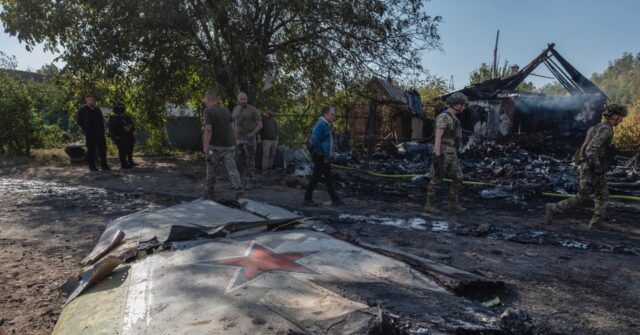Ukrainian forces achieved a notable victory by shooting down a Russian fighter plane near the city of Kostiantynivka in Donetsk province. The head of the Kostiantynivka Military Administration, Serhiy Horbunov, confirmed the incident, which resulted in the aircraft crashing onto a house and igniting a fire. This downing of the Russian bomber highlights the ongoing tensions and exchanges of fire between the two countries, as both sides continue to assert their military efforts in a conflict that has persisted for years. As Ukraine claims successes such as this, Russia simultaneously reports gains in the region, creating a dynamic and competitive narrative regarding control and military effectiveness.
On the same day, the Russian Defense Ministry announced that it had captured the village of Zhelanne Druhe in Donetsk province. Should this claim be verified, it would mark a significant development, occurring just days after Ukrainian forces withdrew from the front-line town of Vuhledar. The loss of Vuhledar, after two years of intense defense by Ukrainian troops, reflects a challenging shift in the military landscape for Kyiv. The implications of this change are critical, as it adds to the growing concern among officials about Ukraine’s strategic position, which has been exacerbated by perceived limitations imposed by allied nations, particularly the United States, regarding Ukraine’s military capabilities.
Ukrainian President Volodymyr Zelenskyy is proactively addressing these challenges by preparing to unveil his “victory plan” during the upcoming meeting of the Ramstein group of nations, scheduled for October 12. This gathering, which will be the first involving leaders in the discussion of military support for Ukraine, is viewed as an opportunity to galvanize international support and resources. Zelenskyy emphasized that delivering a clear and actionable plan is essential for achieving a “just end to the war.” His previous discussions with U.S. President Joe Biden have indicated the plan could include critical components such as Ukraine’s aspirations for NATO membership and the provision of long-range missiles to target deep into Russian territory.
The ongoing conflict continues to take a severe human toll, evidenced by recent reports of casualties resulting from Russian shelling in Ukraine’s southern Zaporizhzhia region. Regional Governor Ivan Fedorov confirmed that two individuals died as a result of these attacks. Additionally, Ukraine’s air force has reported a range of missile and drone assaults from Russia, although many were successfully intercepted. Furthermore, the environment remains volatile, with reports of Ukrainian drone strikes causing injuries, including an incident involving a passenger bus in the partially occupied city of Horlivka. This illustrates the persistent dangers faced by civilians and military personnel alike amid the fighting.
Russia’s Defense Ministry has also claimed successes on their side, stating that their air defenses managed to shoot down ten Ukrainian drones in various border regions. The ongoing exchanges of drone and missile fire highlight the active military engagement and the significant investments by both Ukraine and Russia in aerial capabilities. This multifaceted conflict continues to showcase the strategies employed by each side, as they seek to undermine one another while maintaining their operational effectiveness in an ever-evolving battlefield landscape.
In summary, the conflict in Ukraine remains fraught with tension, as both sides claim victories and report losses in the ongoing struggle for control over contested territories. The recent shooting down of a Russian fighter plane by Ukrainian forces adds to the narrative of resilience and resistance demonstrated by Ukraine. However, the loss of critical positions such as Vuhledar indicates significant challenges lie ahead. President Zelenskyy’s forthcoming “victory plan,” combined with ongoing military operations, seeks to align both national objectives and international support, as the aim is to forge a path toward peace while enhancing defenses against continued Russian aggression. As the conflict continues, the repercussions for both nations and their populations are profound and far-reaching.

